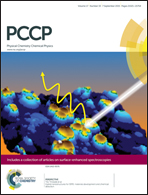Computational design of faster rotating second-generation light-driven molecular motors by control of steric effects†
Abstract
We report a systematic computational investigation of the possibility to accelerate the rate-limiting thermal isomerizations of the rotary cycles of synthetic light-driven overcrowded alkene-based molecular motors through modulation of steric interactions. Choosing as a reference system a second-generation motor known to accomplish rotary motion in the MHz regime and using density functional theory methods, we propose a three-step mechanism for the thermal isomerizations of this motor and show that variation of the steric bulkiness of the substituent at the stereocenter can reduce the (already small) free-energy barrier of the rate-determining step by a further 15–17 kJ mol−1. This finding holds promise for future motors of this kind to reach beyond the MHz regime. Furthermore, we demonstrate and explain why one particular step is kinetically favored by decreasing and another step is kinetically favored by increasing the steric bulkiness of this substituent, and identify a possible back reaction capable of impeding the rotary rate.


 Please wait while we load your content...
Please wait while we load your content...